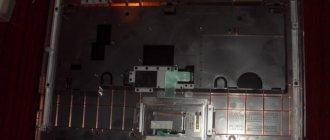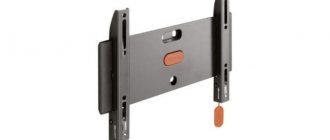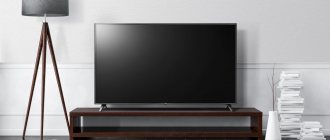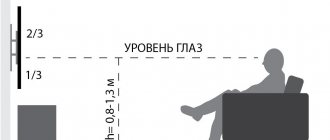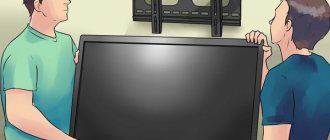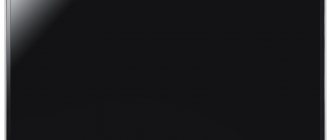With the advent of modern flat and lightweight screens, it has become possible to place televisions not only on legs, stands or pieces of cabinet furniture, but also to hang them from a wall or ceiling. It’s quite possible to do this yourself, saving on installation services. But before that, it is advisable to study all installation methods in order to choose the most suitable one, decide on the location, and take into account important nuances.
Wall mounting is the most popular way to install modern TV devices
Pros and cons of wall installation
All flat-panel TV models come with stands for installation on a flat surface. They are made in the form of supports, secured with screws on the back of the panel body or inserted into special grooves. This is very convenient for those who are replacing old equipment with new ones: you don’t need to think about where to put the purchase, just screw the legs to it and install it in place of the old “box”.
But most owners of flat panels prefer to mount them to the wall, since this installation method provides many advantages, especially relevant for small spaces.
- Saving space - no need to take up space with a TV stand.
- Saving money - a standard hanging mechanism (bracket) costs less than the same cabinet.
- Convenience of using the TV due to placement at a comfortable height and anywhere in the room.
- Safety of operation - the absence of unnecessary furniture that you can trip over or hit, as well as hanging wires that are hidden in grooves, boxes or behind the panel itself.
On a note! Maximum comfort and safety of using the device is ensured by a pre-planned layout of equipment and power outlets.
Having thought in advance about the placement of the TV, you can hide the cables in a special niche.
The wall installation method also has disadvantages. First of all, this is the inability to move equipment to another place without the need to mask holes in the wall left by fasteners. The second drawback is the lack of a horizontal plane for installing a game console, Wi-Fi receiver and other gadgets connected to the TV. For them, you will have to consider the possibility of mounting a shelf next to the TV.
Shelf for devices connected to the monitor
How to find out which bracket is needed for a TV
The bracket at its attachment points must exactly coincide with the mounting recesses on the back wall of the TV, determined by VESA standards. The most common sizes are: 10×10, 20×20 and 60×40 cm.
A holder with a large seat width is suitable for any screen due to adjustable dimensions. But there is no way to attach a large-screen TV to a small bracket. Therefore, before purchasing a mount, it is recommended to measure the gaps between the recesses located behind the monitor.
Choosing a place on the wall for the television panel
To choose the optimal location of the “plasma”, you need to take into account its size, area and purpose of the room, and the strength of the walls.
Distance to monitor
This is one of the most important parameters for proper installation, affecting the comfort of watching TV shows and eye strain. The distance of a person from a television picture depends on the diagonal of the screen:
- 2.5 meters – with a diagonal of 32 inches (80 cm);
- 3 meters - with a diagonal of 40 inches (100 cm);
- 4 meters – with a diagonal of 55 inches (138 cm) or more.
Therefore, you should not buy a TV that is too large for a small room, since it will not be possible to provide the necessary distance, and watching it will be uncomfortable.
Here the distance clearly does not correspond to the width of the screen
Height above floor
To prevent your eyes and neck from getting tired during a long TV session, an imaginary horizontal line dividing the screen into two equal parts should be slightly above eye level. It is clear that people have different heights, but absolute accuracy is not required here. But you need to consider in what position they will watch TV. And this depends on the room in which it is installed.
- Living room . This room usually contains a relaxation area for the whole family with upholstered furniture. It is best to hang the TV on the wall opposite this area at a height corresponding to the seat height of a person in a chair or on a sofa. Usually it is 120 cm with slight deviations in one direction or another.
- Bedroom . In this room they watch TV while lying or half-sitting in bed. To determine the level of installation of the monitor that is most comfortable for your favorite position, you need to accept it by hanging a picture or other improvised screen on the opposite wall. Then move it up or down until you find the most comfortable position.
Advice! If the bedroom is small, it is better to fix the panel higher so that it does not interfere with free movement, but provide for the possibility of changing its inclination relative to the vertical plane. This can be done using a special bracket.
This position of the screen cannot be considered comfortable - it is better to hang it higher and tilt it forward
- Kitchen . This is the most difficult place to install a TV comfortably. As a rule, it is placed opposite the dining area, but ideally it should also be visible from the desktop. It is not always possible to combine this, especially if you take into account the specifics of the kitchen with a large number of cabinets and household appliances. The monitor should not be placed near an oven, steamer or other devices that heat up and produce steam. It should not interfere with free movement or opening cabinets. Therefore, most often it is suspended at a decent height - and here again you cannot do without mechanisms that allow you to change the position of the screen.
In the kitchen you have to sacrifice comfort for safety.
Note! A TV is an electrical device that heats up when in use. Therefore, it cannot be placed in a small niche or in a tight space between furniture elements - this will interfere with normal ventilation and natural cooling, and will lead to rapid failure of the equipment.
Video – TV wall decor ideas
Top 5 Most Reliable TV Mounts
Even relatively small television panels have significant mass. The greatest demand among buyers is for wall brackets that retain high strength despite their compact size. Such mounts can easily withstand the weight of the TV panel specified in the specifications, and after many months the screens work just as well as immediately after installation.
Vogels Thin 345
One of the thinnest tilt-and-turn TV wall mounts is designed for TV screens with a diagonal of 40-65. The mount can be pulled out from the wall, rotated to the sides by 180° and tilted forward up to 20°. The device comes with all the necessary fasteners, is easily mounted on the wall, and allows you to hide the wires from the TV so that they do not disturb the interior.
Vogels Thin 345 can support monitors up to 25 kg, and the average cost of the device is 12,000 rubles
Ergotron 45-353-026
The pan-tilt wall mount can support monitors weighing up to 11.3 kg and monitors up to 42 inches diagonal. The mount can be adjusted in height and moved forward; all connecting cables from the TV are hidden in a special channel and do not attract attention to themselves.
The tilt angle of the holder is 75° down and 5° up, the screen can be rotated in landscape or portrait mode. The TV can be moved horizontally within 83 cm, and vertically up to 51 cm. The model is available for 26,000 rubles.
The Ergotron arm is not designed for heavy screens, but provides ample tilt and swivel capabilities
Brateck PLB-M04-441
In our review of TV brackets, you need to include a reliable mount with a built-in motor. The device allows you to rotate the screen 30° in both directions. Controlled remotely via a remote control, all wires of the TV monitor can be hidden in special channels. The mount is designed for devices with a diagonal of 32-55, the maximum load capacity is 35 kg. The only disadvantage of the holder is that the TV cannot be tilted up or down with its help.
You can buy a Brateck bracket for an average of 14,000 rubles
iTechmount PLB-120
Very durable wall bracket with a maximum load of 100 kg. Supports diagonals from 60 to 100 inches, can extend up to 130 cm from the wall surface. The black wall mount allows you to tilt the TV up and down by 15°, but does not rotate to the sides. The holder has a long warranty and can serve for at least 10 years.
The price of the iTechmount holder is low - about 4,000 rubles
Kromax DIX-15 White
A beautiful tilt-and-swivel bracket for a small TV, suitable for monitors weighing up to 30 kg and a diagonal of 28 inches. The design is easily mounted on the wall, allows you to move the TV away from its surface, rotate it up to 180° left and right, and tilt it 15° in the vertical plane. Supports 2 VESA standards - 7.5 by 7.5 and 10 by 10 cm, made of durable wear-resistant steel.
The Kromax holder belongs to the budget category - its price is 1,500 rubles
How to choose the right bracket
The range of brackets for mounting flat-panel monitors to the wall is very diverse. Among them there are both universal ones, suitable for models from different manufacturers, and special ones, developed for a specific brand.
When purchasing, you should also pay attention to the method of fixing the TV, the recommended maximum load and the equipment of the selected bracket.
Fixation method
Different types of brackets differ from each other in the ability to adjust and change the position of the television device relative to the wall.
- Fixed fasteners are the simplest, most reliable and inexpensive. It has no moving elements, so it holds the panel in a plane parallel to the wall and does not allow it to be moved in any way. This can be inconvenient if viewers decide to change their “dislocation” while watching or if bright light from a window falls on the screen at a certain time of day.
Fixing bracket - Inclined fasteners allow you to change the angle of the monitor within certain limits, usually not exceeding 20 degrees in either direction from the vertical. Used when the TV is placed high or in the bedroom: if you want to watch it lying down or sitting, you just need to slightly adjust the tilt.
Tilt Mount - Rotary and tilt-rotate fasteners are significantly more expensive than previous models, but are more functional. With its help, the monitor can easily rotate as desired and in any plane, turning left and right and tilting up and down.
The mounting panel of the bracket rotates in all directions - The retractable bracket is the most expensive and bulky, but also the most functional, since in addition to changing the angle of the screen and its rotation, it allows you to change the distance from the wall. This can be very convenient when the TV needs to be installed in the kitchen, in a large room or between adjacent rooms.
This design will ensure comfortable viewing from any part of the room.
On a note! For those who value the mobility of the device, floor and table stands with holders for a TV monitor and hidden cable routing have been developed.
Stand with bracket
Video - How to choose a TV bracket
Prices for TV brackets
TV bracket
Equipment
When choosing fasteners, you should make sure that the main and additional elements included in the composition correspond to the configuration declared by the manufacturer. The cheapest brackets are the standard configuration, which in addition to the product itself includes only hardware for installation in the wall. But they may not be suitable for the walls in your home, and this must be clarified immediately in order to purchase the right ones.
More expensive models can be equipped with:
- necessary tool (screwdriver, hex wrench, etc.);
- decorative boxes for hidden laying of wires and cables;
- various holders and shelves for additional accessories;
- remote control for contactless adjustment of the screen position - tilt angle, rotation.
Motorized TV Mount
Maximum permissible load
When purchasing a mount, you must be provided with a product passport and a warranty card. The passport must indicate the permissible load on the bracket, which cannot be exceeded. And if the product has movable joints, then it is recommended to reduce it by at least 10% if the bracket is made by a reputable manufacturer, and by 15-20% if it comes from China.
Another point that requires close attention is the quality of workmanship, the absence of bent parts, chips, unpainted areas and other defects. The presence of which indicates a lack of control over the quality of products.
Types of TV brackets
According to the place of fixation, they distinguish:
- wall;
- ceiling;
- table brackets.
There are four types of factory wall mounts on the market:
- fixed;
- inclined;
- tilt-rotary.
Additionally, we can mention the rack-brackets that are placed on the floor. This is a regular metal structure with fasteners on vertical posts.
For outdated CRT models with a cathode ray tube, a shelf bracket is required. The principle of mounting to the wall is no different, but the TV itself is simply placed on a shelf. For safety, these brackets have a lamp that holds the TV.
Shelf models can also be used for light-weight, thin TVs. There are options with a glass surface.
It is not always necessary to buy the most expensive option with the ability to tilt and rotate television equipment. In many cases a conventional fixed bracket is required. The choice depends on the room where you will watch television.
Fixed
Structurally, it is made of two parts:
- wall mount;
- television
Does not have regulation functions. The TV screen is hung in a strictly perpendicular position relative to the floor.
Suitable for a room where there are no objects that interfere with the installation of the TV. If you hang the TV on a wall with a fixed structure very high, then viewing will become uncomfortable. In addition, high altitude will cause regular neck swelling and eye fatigue during prolonged viewing.
Selected for bedrooms, halls. But provided that there are no high interior items at the installation site - cabinets, fireplaces, etc. Then the installation is done so that the eye level coincides with the center of the screen (living room) or with the lower third (bedroom).
With a fixed design, space is saved as the body rests as tightly as possible against the wall.
Inclined
Externally it is almost identical to the fixed one. But there is an adjustment groove that allows you to tilt the TV up or down.
Suitable for bedrooms and living rooms where there is a tall object in the intended installation location. Then the TV is hung higher and tilted down slightly.
Older models may contain grooves instead of rotating axles to change the angle of inclination. Rearranging the mount increases or decreases the inclination.
Pan-tilt
There are two subspecies:
- with one knee;
- two-knee.
The first may be with a short elbow, which is intended only for adjustment in two axes. Installed in rooms where the TV is located in almost direct line of sight. A common area of application is kitchens.
The long single-arm bracket allows you to move the TV forward and make significant horizontal adjustments. Useful for combined rooms or where the TV is viewed in different places. It will be possible to deploy equipment to almost any point.
The two-leg fastener contains an additional bar, which increases the possibilities of adjustment. The scope of application is identical to the bracket with one elbow.
Such brackets can be hidden in cabinets. Used when installed in the corners of the room.
Not recommended for mounting in a bedroom with a narrow passage between the bed and the wall for two reasons:
- the passage narrows even more, since the bracket takes up significant space behind the TV screen;
- viewing is carried out only from the bed, so adjustment is useless. Just overpay for the complexity and functionality of the design.
Ceiling
Needed if:
- non-standard mounting of equipment is required (for example, right in the center of the room);
- The hanging wall is fragile. Then the TV is fixed through a bracket to the ceiling;
- makes it easier to install in corners.
If the walls are strong, it is better not to use ceiling fasteners.
The standard bracket is always hidden behind the TV body. The ceiling option will always be visible. Over time, the visible bracket can become very annoying.
Desktop
The main purpose is to install monitors at the desktop. They are attached through a clamp - a nut clamp that is pressed against the edge of the table. Therefore, the table surface does not need to be drilled.
Bracket Mounting
Most fasteners are detachable and consist of two elements. One of them is mounted on the back of the TV, and the second is fixed on the wall. After which they are joined using grooves or other types of connections, which differ depending on the type of structure and manufacturer. Therefore, before starting installation, you should carefully read the instructions.
Designation of mounting holes for the inclined model of the universal bracket
As you can see, universal brackets have not one, but a series of holes or an elongated mounting groove, thanks to which they can be adjusted to different models of television devices, sliding and sliding along the guides.
Installation involves performing several sequential operations.
- Fastening the outer part of the product to the rear panel of the device with the bolts included in the kit.
Mounting points on the rear panel - Monitor position markings. A horizontal line is marked on the wall corresponding to the top edge of the monitor. The correctness of its application must be controlled by the level.
Diagram for determining the height of the monitor - Marking the position of the bracket on the wall. The mating part of the product is applied to the part already installed on the TV and the distance from it to the top edge of the monitor is measured. Lay this distance down on the wall from the horizontal markings, drawing a second horizontal line.
Before setting the marks, the position of the plate is checked again with a level - Marking of attachment points. The mounting plate is applied along the bottom markings to the wall and marks are made on it with a pencil through the mounting holes.
Marks are placed with a pen or pencil - Drilling holes. Mounting holes are drilled at the designated points. The choice of drilling tool and fasteners depends on the wall material - a separate chapter will be devoted to this.
Preparing mounting holes in the wall
Advice! When drilling holes, you can keep the nozzle of the vacuum cleaner turned on nearby so that construction debris does not spill onto the floor.
- Attaching the wall part of the bracket. Dowels are inserted into the drilled holes if the wall material requires it, then the bracket is installed in place and secured with screws or other fasteners.
Installing the bracket on the wall - TV panel installation. After checking the strength of the fastening of the wall part of the bracket, the mating part with the TV is hung on it, after which the device is connected to the network.
Attaching the monitor to the bracket
Video – How to install a TV wall bracket
Prices for levels
level
Do all brackets fit TVs?
When purchasing a bracket, it is important not to make a mistake with the choice of design. There are useful recommendations in this regard that must be taken into account:
- Compare the weight of the TV with the maximum permissible weight that the bracket can support.
- Clarify the warranty conditions for the selected design and possible replacement options.
- Select the correct mounting configuration depending on the operating conditions. Basically, preference is given to rotating structures with varying angles of inclination.
- Check the completeness - the presence of bolts, fasteners and other components.
- Decide whether to purchase an expensive automatic bracket with remote control. It is advisable to buy such designs for large TVs that are difficult to move manually.
- The mount and TV must comply with the VESA standard, which is specially designed to streamline mounting and installation. Most of them are completely consistent with each other, you just need to carefully select the appropriate option.
If your TV has a non-standard mount, you should choose universal mounts that are suitable for almost all models.
Other ways to hang a TV on the wall
For some flat screen TVs with a small screen diagonal, it is possible to hang them without additional devices. For this purpose, there are grooves on the back of the panel, specially designed for attaching the plasma by hanging it on bolts screwed into the wall.
To do this, just measure the distance between the grooves, mark them on the wall, drive fasteners into it and fix the TV on it, like a regular poster or mirror. The only difficulty is selecting fasteners designed for the appropriate load.
But this method is not the most convenient, because the monitor fits tightly to the wall, which does not allow you to change its position, place a socket behind it and hide the wires. In addition, the process of ventilation of electronic mechanisms is complicated. Therefore, if the necessary holes are not on the device, or the instructions do not indicate such a mounting option, it is strictly forbidden to use it.
In the absence of factory grooves for direct hanging, it is not recommended to use such fastening methods
But you can make a homemade bracket or hang the TV with the required distance from the wall, using available materials.
Installation on steel angles
From steel corners 3-4 mm thick, 4 pieces are cut, the length of which is 6-8 cm greater than the distance between the mounting holes on the back panel of the TV.
Holes are drilled in one pair of corners for fastening to the back panel of the TV, and in the other for fixing on the wall. After installing each pair in place, they are connected to each other with studs or bolts through holes drilled through.
One pair of corners is attached to the TV through standard mounting holes
The second pair is wall mounted
The corners are fastened together in pairs
Prices for steel angles
steel corners
Installation on furniture corners
Furniture corners are sufficiently rigid and already have holes in the shelves that can be drilled to the required diameter, if necessary.
If you need the TV to hang parallel to the wall, without tilting, then 4 corners are screwed to the back panel - one in each mounting hole. Moreover, the top pair should be fastened with the horizontal shelf facing upwards.
If there are no lower corners or their smaller size, the monitor will hang at an angle
Two corners are attached to the wall at the same distance from each other with the shelf down. Bolts are inserted into them with the rod facing up and must be securely secured with nuts. The corners screwed to the TV are placed on these rods.
The large corner in the center also provides the desired slope
Prices for furniture corners
steel furniture corners
Rotating mechanism made of steel plates and profile pipes
To make such a movable mount yourself, you need to take two steel plates, two pieces of square pipe, bolts for connecting the parts and wall fasteners.
Short sections of pipe are welded to each plate. Through holes are drilled in them, as in two long sections. All these sections are connected to each other by long bolts or studs with nuts.
One plate is fixed on the TV, the other on the wall
There are many other ways. One of the most basic ones is to fix a piece of thick board or block on the wall, and furniture hangers with “ears” on the TV. Screw regular wood screws into the block and hang the monitor on them.
Prices for profile pipes
profile pipes
Video - Bracket made of profile pipes
How about a homemade bracket
If you are not worried about the design of the bracket on the back of the TV, then you can make your own mount at almost no cost. This makes a lot of sense, since for the simplest fastenings you don’t need to cook or saw anything. And the cost of all parts will not exceed 150-200 rubles.
The factory bracket will still have to be hung on the wall. This means you will need to drill holes in the wall. So why not move away from the idea of spending a lot of money, and build fasteners using a couple of corners and a few bolts.
To create the easiest option you will need:
- two single corners for wall hanging furniture;
- a pair of bolts with nuts and washers of the appropriate diameter for the holes in the corners;
- bolts for the lower mounts so that the screen hangs vertically and not tilted downwards;
- plastic dowels and screws to secure the corners in the wall.
Installation instructions:
- Screw the corners to the upper fasteners on the body of the television receiver.
- Screw the bolts into the lower mounting holes to a length that matches the side of the angle. The bolts from below will rest against the wall, which will prevent the TV from tilting under its own weight.
- Measure the horizontal distance between fasteners.
- Draw a level line on the wall and drill two holes at a certain distance in step 3.
- Drive the expansion dowels into the wall all the way so that the caps do not protrude.
- Screw the corners with screws.
- Screw the bolts into the holes on the protruding sides of the corners so that the caps point down and the pin points up.
- Attach the TV corners to the bolts in the wall corners.
If the distance between the TV and the wall is not enough to properly insert the antenna cable, then use a V-shaped adapter.
Mounting to walls made of different materials
Even the most reliable bracket will not hold the TV on the wall if the wall itself is not strong enough. Before starting installation, you need to find out what it is made of and how firmly it can hold the fasteners.
To concrete and solid brick
Walls made of monolithic concrete and solid brick are the most reliable foundation. The holes in them are drilled with a hammer drill, and dowel-nails or anchor bolts are used as fasteners.
Fastening to a concrete wall
To the tree
This is the most trouble-free material for hanging any equipment, provided the wood is sufficiently thick and of good quality. The brackets are attached to wooden walls with ordinary self-tapping screws, the size of which will ensure that the calculated weight of the device is retained.
For foam blocks and hollow bricks
Wall materials with voids and cavities are not able to withstand heavy loads - they crumble from the applied vertical forces. To ensure reliable installation of the bracket with the TV mounted on it, you need to use special screw dowels with an elongated spacer and wide threads or chemical anchors.
Before installing a chemical anchor, the cavity is filled with quick-hardening compounds
Video - Installation of chemical anchor
To drywall
The method of attaching to drywall depends on the weight of the TV and whether there is a solid foundation underneath the drywall trim. This is a rather fragile material, so installation of any suspended structures on it requires preliminary preparation and the use of special fasteners.
The first method can only be used for installing small monitors on the wall, the weight of which, together with the bracket, does not exceed 10-15 kg. To do this, you will need butterfly dowels, which, when a self-tapping screw is screwed into them, open from the back side of the skin, increasing the area of contact of the fastener to the plane and distributing the load on it.
Butterfly dowel - special fastener for drywall
If the monitor is large and heavy, choose a different mounting method - using long hardware that can pass through the drywall and go deep into the load-bearing wall or partition made of durable materials located behind it. In this case, the type of fastener is selected in accordance with the material of these walls.
Fastening with a long pin through plasterboard sheathing
The described method cannot be applied to plasterboard partitions and false walls, since there is no solid foundation behind them. Therefore, when constructing them, the installation of the TV is planned in advance by installing wooden mortgages at the required level or securing additional metal profiles to the frame.
Installation diagram of a plywood embedding platform
If such mortgages were not provided during the renovation, the TV will have to be installed on a cabinet or purchased a floor bracket-stand.
Prices for butterfly dowels
Butterfly dowel
Video - How to make embeds in a plasterboard wall
Where to put the wires
A power cord running from the TV to the outlet and a dangling antenna cable not only spoil the interior - they create a dangerous situation. By accidentally pulling the wire or tripping over it, you can damage the connectors or even drop the equipment on the floor. And if there are small children and animals in the house, they are at risk of injury from electric shock.
To prevent this from happening, the wires must be hidden. Ideally, you should think about this during construction or renovation, immediately deciding on the location of the TV and placing the socket behind it. For the antenna cable, you can cut a channel in the wall or hide it behind plasterboard cladding.
If you bought a new TV when all the repair and finishing work has long been completed, use decorative methods to disguise the wires - lay them in cable channels, under moldings, in chrome tubes. The choice of “case” depends on the style of the interior.
The black cable channel fits perfectly into the minimalist interior style
Another way is to fix the wire on the wall in several places and disguise it as a tree or vine, attaching elements of artificial plants or decorative stickers to it and to the wall itself.
Disguising wires as a plant
Another practical idea is to hang the TV on the opening facade of a homemade structure in the form of a niche with shelves.
An original way to hide wires and TV accessories
Prices for cable channels
Cable channels
Video - Methods for masking wires
Bracket selection
To hang the TV on the wall, you need to select brackets. First of all, look at the back cover of the device. There should be four holes for installing mounting plates. You need to measure the distances between them and the post when choosing a bracket, focus on them.
There are brackets in which all four fasteners are fixed, and there are more universal ones in which the horizontal distance varies.
It is necessary to focus on the distance for fasteners
Next, select the type of bracket for the TV:
- For fixed installation. They consist of two plates - one is mounted on the wall, the second on the back wall of the TV. When installed, the screen is simply hung on a plate hung on the wall. The mounting takes up little space, the monitor is located almost close to the wall. There remains a very small gap - 10-20 mm.
You can hang a TV on the wall like a picture - at a short distance from the wall using similar brackets
- With rotation in the horizontal plane, that is, the screen can be rotated left and right. This type of TV bracket protrudes from the wall at a certain distance, most often a small one - a few centimeters. Otherwise you won't be able to turn. These models provide up/down tilt
- With vertical rotation - you can tilt the screen slightly down/up. This type of bracket is most often used in kitchens. After all, there TVs are mounted high on the wall, and in order to watch comfortably, you need to tilt the screen a little. There are different options
- With the ability to rotate in both planes. This is a good option, but such brackets cost a lot.
The most common TV brackets are regular ones. Few cases require the ability to rotate the screen, mainly only in the kitchen. Therefore, there is no point in overpaying for unnecessary options.
In addition, the TV bracket must be selected according to weight and diagonal. This is one of the most important criteria and the safety of your equipment depends on it.



